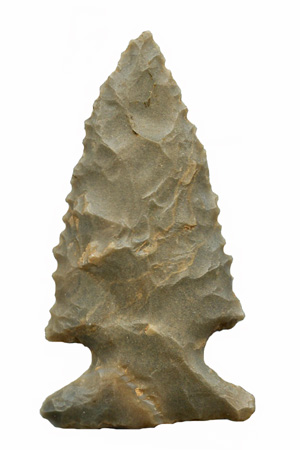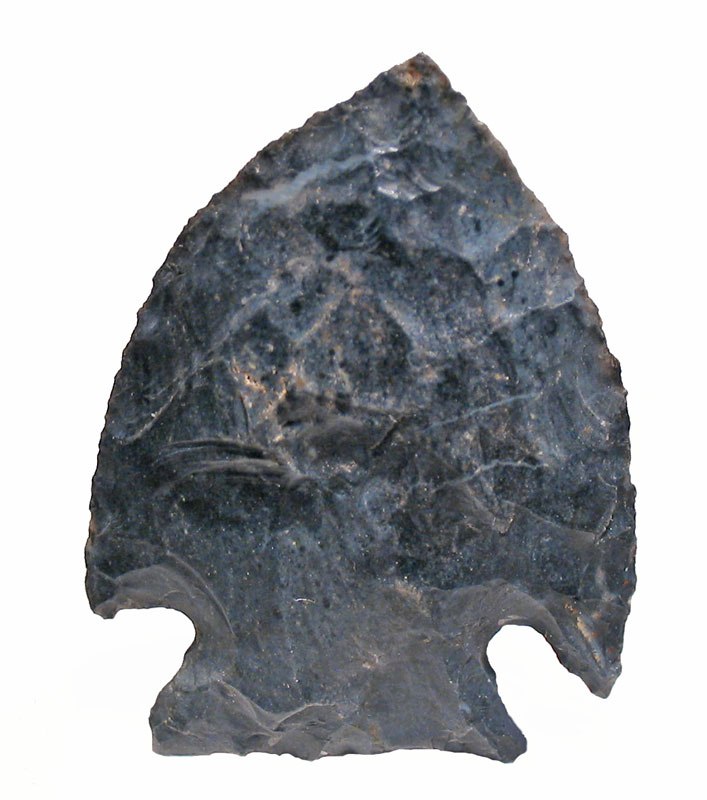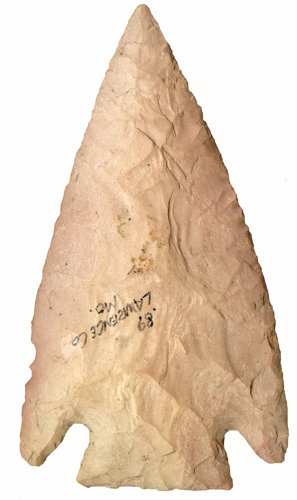





Point Type:
KIRK CORNER NOTCHED
Also See: Amos Corner Notched, Barbee Corner
Notched, Brewerton Corner
Notched , Cave Spring, Charleston Corner Notched, Crawford Creek
Notched, Cypress Creek, Kirk Stemmed
, Palmer, Rice Concave Base, St. Albans,
Stilwell
Location: Eastern Central, Eastern Seaboard, Southeastern
States
Associated Dates: 9000 - 6000
B.P. -
Early Archaic to Middle
Archaic
Morphology: Corner Notched
General Description: The Kirk Corner
Notched point type is a medium to
large sized, triangular shaped blade (sometimes serrated) with a short
straight base that is rarely ground but often is slightly smoothed . Serrations can oftentimes be missing due to
heavy blade usage (probably as a knife in cutting and sawing
activities). The shoulders terminate in sharp barbs that project towards the
base. On some specimens the barbs are rounded. The robust serration common to these points
often distorts the overall symmetry of the blade
contour in the reworking process. The basal edge is thinned by
removal of flakes from the bottom of the
base. The blade usually exhibits early
parallel flaking and is often
asymmetrical
. The blade edges are usually
incurvate or
recurvate and can be
beveled
and / or
serrated.
The Kirk Corner Notched is found all over the
entire Eastern United States and into Texas and Louisiana.
The
typical dimensions of the Kirk Corner
Notched are as follows. The length can range from 32mm to 120mm with the
average being 70mm. The width can range from 21mm to 37mm with the average
width being 29mm. The thickness ranges from 6mm to 12mm with the average
being 8mm in thickness.
The Kirk Stemmed Point was named by Joffre L. Coe
in 1964 for points found at the
Hardaway site in North Carolina. Coe initially thought that the point
type was two separate types: The Kirk Stemmed and the Kirk Serrated. These two
types, are for the most part, only differentiated by the amount of reworking on
the blade edges (serrations). Coe suggested that the original outline of the
point was a long dagger-like blade profile with deep serrations and a broad
stem.
Other Kirk Tradition types blend into this type including the
Palmer Corner Notched, Charleston Corner Notched, Amos Corner Notched, Rice
Concave Base, and the Kirk Stemmed / Serrated. The Stillwell type as
described by Perino may be a variety. The Crawford Creek Notched, the
Barbee Corner Notched all appear to be identical to the Kirk Corner Notched type.
About The Point Above (Left - Shown
Twice Size): The medium sized Kirk Corner
Notched and point pictured at the top left hand side of this page,
was found in Putnam County, Tennessee. It is made from a glossy
gray Hornstone material that has some light tan colored streaks.
The blade surface has some very nice flaking and the blade is quite thin.
The base is very slightly ground. The specimen measures 43 mm in
length, 22 mm wide across the barbs, and is only 6.4 mm at its thickest point at
mid blade. The base tapers down to 3.9 mm in thickness. The stem length
is 10.9 mm and is 23 mm wide The point was formerly in the Will
Burkett collection and the Rocky Hall collection.
Catalog Number
419-18-HH
About The Point Above (Center -
Shown Twice Size):
About The Point Above (Right): The large Kirk Corner Notched and point pictured at the top right hand side of this page, was found in Lawrence County, Missouri and was once in the John R. Adams collection of Lawrenceville, IL. The blade is made from a dull matte finish cream colored chert material which could be Burlington Chert. There is very good patination on the blade surface and knapping scars. The blade surface has some very nice flaking and the blade is quite thin. There is an old ding on the left hand blade edge. The base is not ground. The specimen measures 90 mm in length, 49 mm wide across the barbs, and is only 8.2 mm at its thickest point just above the notches in mid blade. The base tapers down to 3.5 mm in thickness. The stem length is 11.7 mm and is 28.4 mm wide. Catalog Number 61-90-O
References: Coe, DeRegnaucourt, Dragoo, Hranicky (1), Henschel, Justice (1), Overstreet, Perino (1)
© Copyright 1997 - 2009 LITHICS-Net WWW.LITHICSNET.COM
Use your Browser's BACK Button to return to the LITHICS-Net Index.